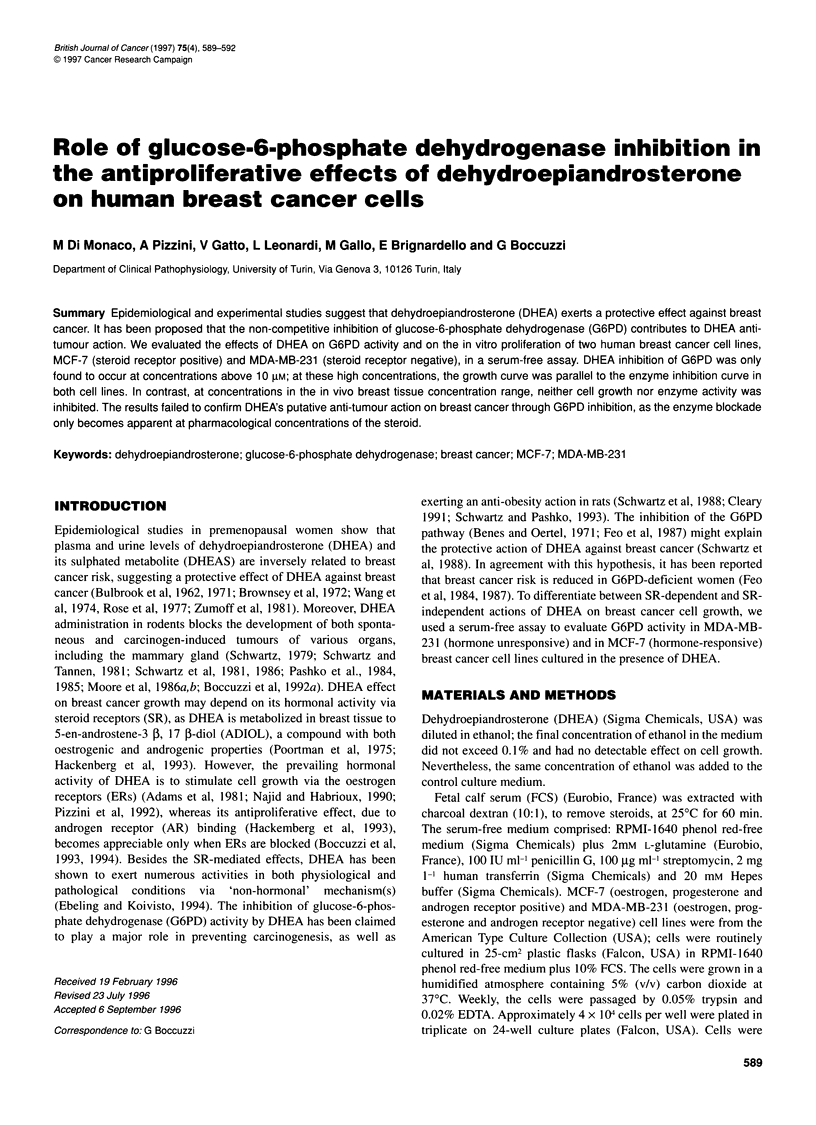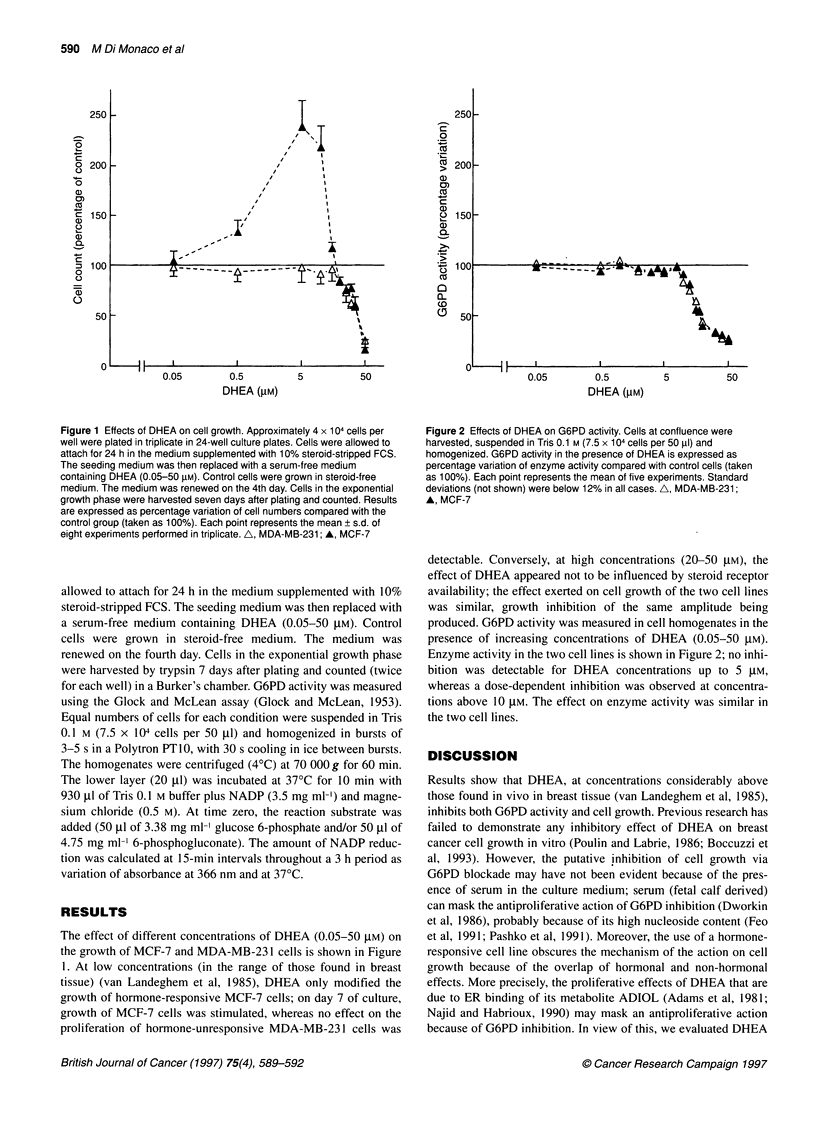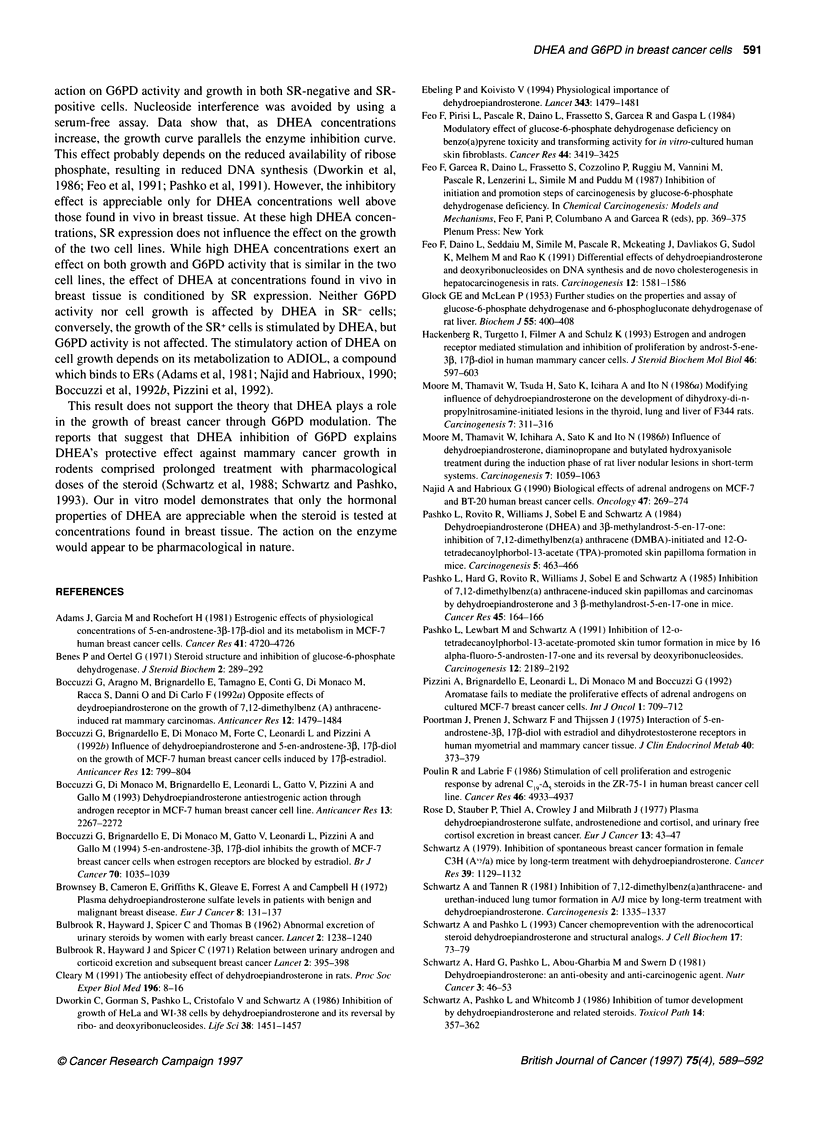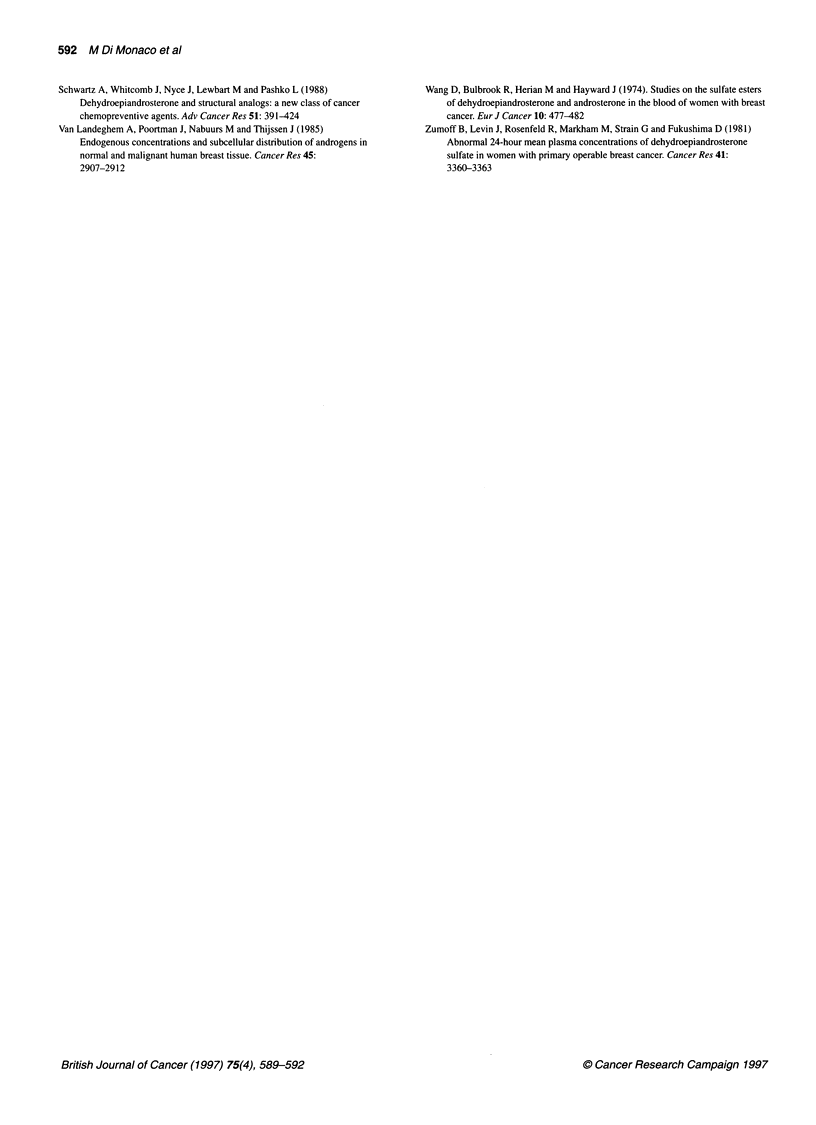Abstract
Epidemiological and experimental studies suggest that dehydroepiandrosterone (DHEA) exerts a protective effect against breast cancer. It has been proposed that the non-competitive inhibition of glucose-6-phosphate dehydrogenase (G6PD) contributes to DHEA antitumor action. We evaluated the effects of DHEA on G6PD activity and on the in vitro proliferation of two human breast cancer cell lines, MCF-7 (steroid receptor positive) and MDA-MB-231 (steroid receptor negative), in a serum-free assay. DHEA inhibition of G6PD was only found to occur at concentrations above 10 microM; at these high concentrations, the growth curve was parallel to the enzyme inhibition curve in both cell lines. In contrast, at concentrations in the in vivo breast tissue concentration range, neither cell growth nor enzyme activity was inhibited. The results failed to confirm DHEA's putative anti-tumor action on breast cancer through G6PD inhibition, as the enzyme blockade only becomes apparent at pharmacological concentrations of the steroid.
Full text
PDF



Selected References
These references are in PubMed. This may not be the complete list of references from this article.
- Adams J., Garcia M., Rochefort H. Estrogenic effects of physiological concentrations of 5-androstene-3 beta, 17 beta-diol and its metabolism in MCF7 human breast cancer cells. Cancer Res. 1981 Nov;41(11 Pt 1):4720–4726. [PubMed] [Google Scholar]
- BULBROOK R. D., HAYWARD J. L., SPICER C. C., THOMAS B. S. Abnormal excretion of urinary steroids by women with early breast cancer. Lancet. 1962 Dec 15;2(7268):1238–1240. doi: 10.1016/s0140-6736(62)92812-x. [DOI] [PubMed] [Google Scholar]
- Boccuzzi G., Brignardello E., Di Monaco M., Gatto V., Leonardi L., Pizzini A., Gallo M. 5-En-androstene-3 beta,17 beta-diol inhibits the growth of MCF-7 breast cancer cells when oestrogen receptors are blocked by oestradiol. Br J Cancer. 1994 Dec;70(6):1035–1039. doi: 10.1038/bjc.1994.444. [DOI] [PMC free article] [PubMed] [Google Scholar]
- Boccuzzi G., Di Monaco M., Brignardello E., Leonardi L., Gatto V., Pizzini A., Gallo M. Dehydroepiandrosterone antiestrogenic action through androgen receptor in MCF-7 human breast cancer cell line. Anticancer Res. 1993 Nov-Dec;13(6A):2267–2272. [PubMed] [Google Scholar]
- Brownsey B., Cameron E. H., Griffiths K., Gleave E. N., Forrest A. P., Campbell H. Plasma dehydroepiandrosterone sulphate levels in patients with benign and malignant breast disease. Eur J Cancer. 1972 Feb;8(1):131–137. doi: 10.1016/0014-2964(72)90094-1. [DOI] [PubMed] [Google Scholar]
- Dworkin C. R., Gorman S. D., Pashko L. L., Cristofalo V. J., Schwartz A. G. Inhibition of growth of HeLa and WI-38 cells by dehydroepiandrosterone and its reversal by ribo- and deoxyribonucleosides. Life Sci. 1986 Apr 21;38(16):1451–1457. doi: 10.1016/0024-3205(86)90557-6. [DOI] [PubMed] [Google Scholar]
- Ebeling P., Koivisto V. A. Physiological importance of dehydroepiandrosterone. Lancet. 1994 Jun 11;343(8911):1479–1481. doi: 10.1016/s0140-6736(94)92587-9. [DOI] [PubMed] [Google Scholar]
- Feo F., Daino L., Seddaiu M. A., Simile M. M., Pascale R., McKeating J. A., Davliakos G. P., Sudol K. S., Melhem M. F., Rao K. N. Differential effects of dehydroepiandrosterone and deoxyribonucleosides on DNA synthesis and de novo cholesterogenesis in hepatocarcinogenesis in rats. Carcinogenesis. 1991 Sep;12(9):1581–1586. doi: 10.1093/carcin/12.9.1581. [DOI] [PubMed] [Google Scholar]
- Feo F., Pirisi L., Pascale R., Daino L., Frassetto S., Garcea R., Gaspa L. Modulatory effect of glucose-6-phosphate dehydrogenase deficiency on benzo(a)pyrene toxicity and transforming activity for in vitro-cultured human skin fibroblasts. Cancer Res. 1984 Aug;44(8):3419–3425. [PubMed] [Google Scholar]
- GLOCK G. E., McLEAN P. Further studies on the properties and assay of glucose 6-phosphate dehydrogenase and 6-phosphogluconate dehydrogenase of rat liver. Biochem J. 1953 Oct;55(3):400–408. doi: 10.1042/bj0550400. [DOI] [PMC free article] [PubMed] [Google Scholar]
- Hackenberg R., Turgetto I., Filmer A., Schulz K. D. Estrogen and androgen receptor mediated stimulation and inhibition of proliferation by androst-5-ene-3 beta,17 beta-diol in human mammary cancer cells. J Steroid Biochem Mol Biol. 1993 Nov;46(5):597–603. doi: 10.1016/0960-0760(93)90187-2. [DOI] [PubMed] [Google Scholar]
- Moore M. A., Thamavit W., Tsuda H., Sato K., Ichihara A., Ito N. Modifying influence of dehydroepiandrosterone on the development of dihydroxy-di-n-propylnitrosamine-initiated lesions in the thyroid, lung and liver of F344 rats. Carcinogenesis. 1986 Feb;7(2):311–316. doi: 10.1093/carcin/7.2.311. [DOI] [PubMed] [Google Scholar]
- Najid A., Habrioux G. Biological effects of adrenal androgens on MCF-7 and BT-20 human breast cancer cells. Oncology. 1990;47(3):269–274. doi: 10.1159/000226830. [DOI] [PubMed] [Google Scholar]
- Pashko L. L., Hard G. C., Rovito R. J., Williams J. R., Sobel E. L., Schwartz A. G. Inhibition of 7,12-dimethylbenz(a)anthracene-induced skin papillomas and carcinomas by dehydroepiandrosterone and 3-beta-methylandrost-5-en-17-one in mice. Cancer Res. 1985 Jan;45(1):164–166. [PubMed] [Google Scholar]
- Pashko L. L., Lewbart M. L., Schwartz A. G. Inhibition of 12-O-tetradecanoylphorbol-13-acetate-promoted skin tumor formation in mice by 16 alpha-fluoro-5-androsten-17-one and its reversal by deoxyribonucleosides. Carcinogenesis. 1991 Nov;12(11):2189–2192. doi: 10.1093/carcin/12.11.2189. [DOI] [PubMed] [Google Scholar]
- Poortman J., Prenen J. A., Schwarz F., Thijssen J. H. Interaction of delta-5-androstene-3beta, 17beta-diol with estradiol and dihydrotestosterone receptors in human myometrial and mammary cancer tissue. J Clin Endocrinol Metab. 1975 Mar;40(3):373–379. doi: 10.1210/jcem-40-3-373. [DOI] [PubMed] [Google Scholar]
- Poulin R., Labrie F. Stimulation of cell proliferation and estrogenic response by adrenal C19-delta 5-steroids in the ZR-75-1 human breast cancer cell line. Cancer Res. 1986 Oct;46(10):4933–4937. [PubMed] [Google Scholar]
- Schwartz A. G., Hard G. C., Pashko L. L., Abou-Gharbia M., Swern D. Dehydroepiandrosterone: an anti-obesity and anti-carcinogenic agent. Nutr Cancer. 1981;3(1):46–53. doi: 10.1080/01635588109513700. [DOI] [PubMed] [Google Scholar]
- Schwartz A. G. Inhibition of spontaneous breast cancer formation in female C3H(Avy/a) mice by long-term treatment with dehydroepiandrosterone. Cancer Res. 1979 Mar;39(3):1129–1132. [PubMed] [Google Scholar]
- Schwartz A. G., Pashko L. L. Cancer chemoprevention with the adrenocortical steroid dehydroepiandrosterone and structural analogs. J Cell Biochem Suppl. 1993;17G:73–79. doi: 10.1002/jcb.240531114. [DOI] [PubMed] [Google Scholar]
- Schwartz A. G., Pashko L., Whitcomb J. M. Inhibition of tumor development by dehydroepiandrosterone and related steroids. Toxicol Pathol. 1986;14(3):357–362. doi: 10.1177/019262338601400312. [DOI] [PubMed] [Google Scholar]
- Schwartz A. G., Tannen R. H. Inhibition of 7,12-dimethylbenz[a]anthracene- and urethan-induced lung tumor formation in A/J mice by long-term treatment with dehydroepiandrosterone. Carcinogenesis. 1981;2(12):1335–1337. doi: 10.1093/carcin/2.12.1335. [DOI] [PubMed] [Google Scholar]
- Schwartz A. G., Whitcomb J. M., Nyce J. W., Lewbart M. L., Pashko L. L. Dehydroepiandrosterone and structural analogs: a new class of cancer chemopreventive agents. Adv Cancer Res. 1988;51:391–424. doi: 10.1016/s0065-230x(08)60227-4. [DOI] [PubMed] [Google Scholar]
- Wang D. Y., Bulbrook R. D., Herian M., Hayward J. L. Studies on the sulphate esters of dehydroepiandrosterone and androsterone in the blood of women with breast cancer. Eur J Cancer. 1974 Aug;10(8):477–482. doi: 10.1016/0014-2964(74)90069-3. [DOI] [PubMed] [Google Scholar]
- Zumoff B., Levin J., Rosenfeld R. S., Markham M., Strain G. W., Fukushima D. K. Abnormal 24-hr mean plasma concentrations of dehydroisoandrosterone and dehydroisoandrosterone sulfate in women with primary operable breast cancer. Cancer Res. 1981 Sep;41(9 Pt 1):3360–3363. [PubMed] [Google Scholar]
- van Landeghem A. A., Poortman J., Nabuurs M., Thijssen J. H. Endogenous concentration and subcellular distribution of androgens in normal and malignant human breast tissue. Cancer Res. 1985 Jun;45(6):2907–2912. [PubMed] [Google Scholar]


